
Exeter by-pass - a short history
Page updated 29 October 2009
With the influx of motoring tourists to the west country after the First War, Exeter found itself at the crossroads of incoming routes to Devon and Cornwall. It was obvious by the middle of the 1920's that the city roads would not be able to cope with an expected growth in traffic, especially during the summer months, when the new, car owning, middle class started taking motoring holidays in the resorts and moors of the west country.
By 1927 the Times noted "Not a few of those motorists who have occasion to visit the West of England during the summer months leave Exeter with feelings of relief and memories of unpleasant traffic 'jams' in narrow streets."
The council had proposed that improvements be made to the existing city streets to aid the flow of traffic through the town. The Bude Hotel and the Star and Garter public house, among others, were to be demolished for road widening, while in 1929 traffic lights were introduced into the city for the first time. Paris Street was widened at a cost of £75,000 and a one way scheme in Paris and Summerland Street introduced; it all seems so familiar.
However in the same newspaper report, it was suggested that a 'new by-pass road' be built to divert heavy traffic away from the city. Indeed, in 1926 the Prince of Wales had opened Prince of Wales Road between Union Road and New North Road as the first stage of a proposed northern by-pass, but it was unknown to many approaching the city from the Bath Road and was not much used; of course, it now leads to the university. Schemes to improve the flow of traffic through the city were not enough and by the early 1930's work had started on building the Exeter by-pass.
The Exeter by-pass
Devon County Council recommended a by-pass for Exeter in February 1930, to be built in sections. The first section was completed from Pinhoe to Hill Barton railway bridge and opened.
A tender was accepted, in 1933, of £70,844 from Staverton Builders Ltd., for the construction of the second section of the by-pass from Hill Barton railway Bridge to Countess Wear cross-roads, including a culvert and embankments Countess- Wear. There were 23 tenders, the highest being £142.769 2s 10d.
The second section was completed by 1935. The road had required the construction of a bridge across the A30 Honiton Road, near Gallows Cross, with a slip road to allow traffic from London to join the by-pass, and a roundabout where it crossed the Sidmouth Road at what is now known as Middlemoor.
In August 1935 the construction of the final section of the by-pass between Countess Wear, across the river and canal to join the Dawlish Road and then on to intersect the Torquay and Plymouth roads commenced. This was a more complex engineering challenge as the ancient Countess Wear bridge had to be widened from 13ft 7in (4.14 metres) to 45 ft (30.7 metres) without destroying its 18th-century character. The downstream side of the bridge was demolished and rebuilt in exactly the same style allowing a 30 ft (9.14 metre) carriageway and footpaths to be laid.
Further on, the old 8 ft wide Countess Wear swing bridge with steep approaches, that crossed the canal, was replaced with a new, wider bridge that could take the expected maximum holiday traffic. The Great Western Railway line's existing narrow bridge was widened from 19.5 ft (5.9 metres) to 50 ft (15.25 metres). The junction with the Dawlish Road is a roundabout where the by-pass then followed the Dawlish Road as far as Matford House, before cutting across to intersect the Torquay and Plymouth Road near Peamore House.
On 22 February 1938 the last section of the by-pass, where it joined the Plymouth Road, was opened by Mr Burgin, the Minister of Transport. Taking a special pair of scissors from an inscribed case, he cut the tape to open the road. The Times wrote that the Minister had " said ... The people of Exeter need have no fear of the by-pass for it was better to have willing customers who could reach the city than disgruntled tourists who were delayed on their journeys through being unable to pass through it."
The Minister then travelled into the city to unveil the new, traffic controlled, lights that had recently been installed in the streets.
Traffic Jams
Through the 1950's and 60's traffic jams on the Exeter by-pass were legend, and were, like the swallows, an indication that summer had arrived. When the by-pass was particularly busy, a line of traffic several miles long could back up both the A30 and the A38, while the High Street would still have streams of cars passing along it, trying to avoid the by-pass to join the Okehampton Road in St Thomas. In August 1959 an experimental scheme where a policeman stood on a raised platform in the centre of the Countess Wear roundabout to manually control four sets of temporary traffic lights, was introduced. It was hoped that holiday traffic flow on the Exeter By Pass would be improved.
In August 1965, the good weather delayed the departure of many holiday makers for home. The Express and Echo reported a 12 mile traffic jam stretching from Ideford to Middlemoor. Traffic driving towards the by-pass along the A30 from the direction of Honiton was described as "one long crawl." It was reported that the Exeter by-pass was carrying 1,000 cars per hour southbound, and 900 cars in the opposite direction. One AA man described seeing 70 vehicles parked in one lay-by, and estimated there were 300 vehicles parked up in total. The Express and Echo reported the AA man said "... that he had never seen anything like it before. The position was worse than it had been in previous years."
In 1968 plans were drawn up to build a motorway from Bristol to Exeter that was to be designated the M5. By April 1974 it had been opened as far as Taunton and work on the Sowton section as far as Sandygate commenced in May 1973, to open in October 1975, at a cost of £4.95 million. Bovis the contractors excavated 2,641,000 cubic yards of sandstone and built ten bridges. British Rail also constructed a bridge for the Exmouth line from Exeter.
The last section of motorway around Exeter from Sandygate to Exminster was constructed by Cementation Ltd at a cost of £12.88 million. The crossing of the River Exe is via twin viaducts, each of eleven spans and 2,263 ft in total length (690 metres) while nine other bridges were constructed. The contractors removed 3.174 cubic metres of sandstone, much from the cutting at Pearce's Hill.
The old Exeter by-pass is still a busy road and the section between the Countess Wear roundabout and the Dawlish Road remains a bottleneck, especially at rush hour. And the growth of traffic during the opening years of the present century has seen delays and frustration at a level that would have horrified the council and citizens of Exeter in the 1920's.
Sources - The Times, the Express and Echo and the Motorway Archive Trust.
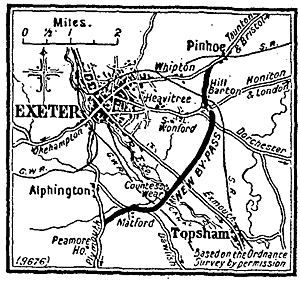 The by-pass ran from Pinhoe to
Peamore. The Times.
The by-pass ran from Pinhoe to
Peamore. The Times.
 Looking back down the A378
towards Bridge Road (left) and Sannerville Way (right) - circa 1955.
Photo Terry Dickens.
Looking back down the A378
towards Bridge Road (left) and Sannerville Way (right) - circa 1955.
Photo Terry Dickens.
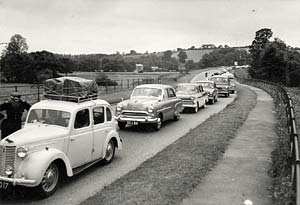 A queue of cars - circa 1955 on the
by-pass. Photo Terry Dickens.
A queue of cars - circa 1955 on the
by-pass. Photo Terry Dickens.
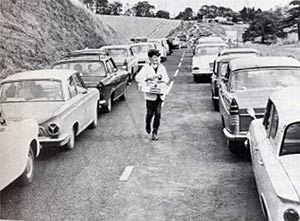 Taking
advantage of the holiday traffic snarl up, an ice cream vendor sells to
captive customers - circa 1965.
Taking
advantage of the holiday traffic snarl up, an ice cream vendor sells to
captive customers - circa 1965.
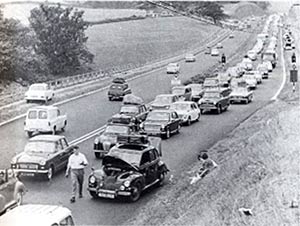 Traffic trying to pass an overheated car
near Peamore in the 1960's. Above photos courtesy of Michael Hawkin.
Traffic trying to pass an overheated car
near Peamore in the 1960's. Above photos courtesy of Michael Hawkin.
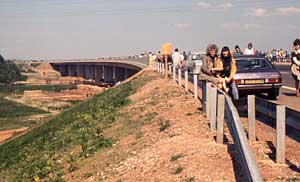 Prior to the opening of the M5 from
Sandygate to Exminster in 1976, pedestrians were allowed to walk across
the Exe river
bridges. Photo courtesy of Lydia Barnard.
Prior to the opening of the M5 from
Sandygate to Exminster in 1976, pedestrians were allowed to walk across
the Exe river
bridges. Photo courtesy of Lydia Barnard.
│ Top of Page │